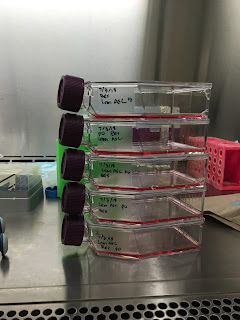Nothing
quite says fourth of July week like a bucket of human fat. This week my clinician was out of town so it was a
great time for me to dig in on my research project. I tried out multiple new techniques
on fat samples to varying degrees of success. My lab in Ithaca studies the breast cancer microenvironment and the differences between lean and obese patients to
understand why obesity is associated with increased rates of breast cancer. My
study here involves analyzing clinical samples correlated to patient BMI. In the plastic surgery department I am
fortunate to have access to patient fat samples from procedures such as breast
reductions or abdominal wall repairs. This week I
worked with breast tissue from a both a healthy and obese BMI range. My research goals are to develop a
decellularized scaffold from the tissue, to analyze the matrix properties, and
to isolate and culture the Adipose Stromal Cells (ASC) for future cell behavioral
analysis. I attempted to isolated the
ASCs for the first time this week from both samples. The process went smoothly
but after 48 hours the number of adhered cells in my flasks were very low so
more optimization is required. Optimization was also required in my decell
project. My embedding in parafin wax and sections didn't come out as well as
it could have but the histology core helped me figure out what may have been
have the problem in my tissue fixation process. It's an easy fix and I now I am
keeping everything at 4 degrees C to stop any potential reactions with the formalin.
This week I
worked with breast adipose samples but in the first few weeks I worked with the
abdominal adipose tissue I saw collected. I have seen several abdominal wall repairs
after hernias. Small hernias can be fixed laproscopically but bigger or more
severe cases require the plastic surgery team to intervene and make large
incisions. The first step is an horizontal incision and a separation of the fat
from the underlying abdominal muscles.
The spot where the intestine is poking through is sutured together, and
techniques such as facial release can be used to relieve tension or to prevent recurrence. Depending on a circumstances of the patient an abdominal mesh could be used. These sheets of mesh can
be degradable or non-degradable but their purpose is to evenly distribute
tension and also act as a second barrier to prevent recurrence of the hernia. The mesh is sutured into place on top of the abdominal muscles. After
the repair is complete, excess abdominal fat is cut off, drain tubing is
inserted, and the skin is sutured back together.
The drains act as a way for the fluid produced at the surgical site to exit the
body and of the external part of the tube is connected to the drain collector which is used to measure patient output. The
drains act as a way for the fluid produced at the surgical site to exit the
body and not interfere with healing. The drains can stay in for 2 weeks or
longer depending on the magnitude of the procedure and how much fluid the
patient produces. This week in clinic I saw many patients for post-op
drain removal or evaluation.
 |
| Figure 1: Comparison between adipose tissue (top) and decellularized adipose tissue (bottom) |
 |
| Figure 2: ASCs plated after isolation from patient breast tissue from a bi-lateral breast reduction |
Life in the
Big Apple
On the fourth of July I went to the Cornell
Tech campus on Roosevelt island to watch
the fireworks. I also walked the high line and ate some great tacos at Chelsea
Market. Last weekend we went to the American Museum of
Natural History were I was delighted to see all the dinosaurs especially titanosaur who's head stuck out of the exhibit hall because it was so long. Shout-out to Jacob and
Raisa for braving the heat to wait in line for Anastasia rush tickets and for
giving me to chance to see to see it with them on Sunday!
No problem! Thanks for putting up with me when I wanted to get autographs of the actors!
ReplyDelete